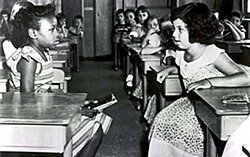 |
 |
 |
|
|
|||||||||||||
|
|
|||||||||||||
| Email Article | Printable Page |
Resegregation
 |
|
Washburn U. School of Law
|
Before Americans commemorated the 50th anniversary of Brown v. Board of Education of Topeka, Kan., researchers at Harvard University reported that the positive effects of that decision had regressed by three decades.
The degree of segregation at public schools has rolled back to where it was in 1969, right after the assassination of the Rev. Dr. Martin Luther King Jr., according to a study by the Civil Rights Project at Harvard.
|
MORE ON BROWN
|
The report found a major increase in �resegregation� in many districts after a 1991 Supreme Court decision, Board of Education of Oklahoma v. Dowell. For example, the percentage of black students attending school with white students in Topeka public schools dropped 8 percent, from 59.4 percent in 1991 to 51.1 percent in 2001. But the highest rate of resegregation was 72 percent in DeKalb County, Ga., on the edge of Atlanta.
In the Dowell case, the Supreme Court ruled that formerly segregated school districts could be released from court-ordered busing once they had taken all "practicable" steps to eliminate the legacy of segregation.
The study, �Brown at 50: King�s Dream or Plessy�s Nightmare,� also said that a majority of the children in intensely segregated minority schools face conditions of concentrated poverty in categories such as building quality, which is greatly related to unequal educational opportunities.
"The appointment of very conservative court justices on the Supreme Court is one of the main reasons the 1991 decision to end court-ordered desegregation was passed down," said Gary Orfield, professor of education and social policy at the Harvard Graduate School of Education and co-director of the Civil Rights Project.
"We have now the most conservative Supreme Court in 75 years, and the only decision that they have made in favor of recognizing race as an issue was the recent Michigan case," added Orfield, co-author of the study.
Yet some Howard law and education students said they did not want to wait for the Supreme Court to settle their community's issues. They have been sponsoring programs related to the Brown case and reviewing its history. Although the decision bears the name of the Rev. Oliver Brown, who wanted his little girl, Linda, to attend a white school in Topeka, it also included cases from three other communities. The other cases joined in the decision, which determined that the practice of separate but equal was wrong, originated in Wilmington, Del., Clarendon County, S.C., and Prince Edward County, Va.
The student-sponsored programs are part of a yearlong commemoration at Howard, where Thurgood Marshall and other lawyers worked on the landmark case. For example, the School of Education held a program assessing today's educational system and the impact of Brown v. Board.
"A lot of our schools are not legally segregated, but still very much so separated by races," said Carmen Callaway, co-chair of the program and secretary of the School of Education Student Council.
"Even though it was a panel discussion, it was more so like a round table where we discussed Brown and it effects on us, as well as what to do to encourage black men and help our families become more accountable."
Another issue concerned motivating better-qualified teachers to teach inner-city children. Educators also have a responsibility to teach students about the importance of Brown v. Board and integration, added Kimberly Jones, a junior majoring in legal communications who wants to become a teacher.
"I am going to have to work harder to encourage children to explore other cultures as well as exploring their value as people," Jones said. "I was blessed to have a very diverse education, and I would like to see teachers, families and the community work hard to show children the importance of experiencing a culture different from their own."
Orfield also says more needs to be done. "One thing we must all remember is that desegregation is just getting people in the door," he said. "True integration is having an institution that is not looked at as a white institution, but as an institution, period.
"We are not there yet,� Orfield said, �but that also doesn't mean that we abandon the schools that are highly segregated now. I don't think anyone who supports integration doesn't support helping the schools that are already segregated."
Posted May 24, 2004
In News
Hip-Hop Generation Debated at "State of Black Union" Conference
Student Journalists Gear Up for HBCU Newspaper Conference
| Home | News | Sports | Culture | Voices | Images | Projects | About Us Copyright © 2007 Black College Wire. Black College Wire is a project of the Black College Communication Association and has partnerships with The National Association of Black Journalists and the Robert C. Maynard Institute for Journalism Education. |